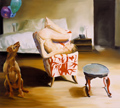|
|
|
| |
Eric Fischl, The Bed, The Chair, Waiting, 2000. |

|
Eric Fischl
Gagosian Gallery, London
Through July 28
Eric Fischl's new paintings constitute a partial return to
the ambiguous, sexually-charged imagery that made him famous. A partial return,
because although these five paintings are set in an expensively Spartan bedroom
and suggest an erotic transaction between a young woman and a middle-aged man,
their real subject is an armchair. The enigma of these works resides not in
narrative lacunae, nor in the occasional visual non sequitur such
as a dog and a string of balloons, but in Fischl's apparently stronger interest
in different presentations of this armchair - which appears in every picture
– than in the social drama unfolding around it.
In one canvas, the armchair –
covered in an iridescent Chinese fabric bearing a red-on-white pattern of lilies
- is occupied by a naked, hairy-chested man. Behind him is a double bed, which
looks as long and streamlined as a Cadillac. It has apparently been recently
used, for in the background is a film-noir-ish shadow of a nude
woman. One is invited to reconstruct the action and to try and understand the
male protagonist's expression. He looks world-weary but, crucially, Fischl has
made such a mess of the face –
covering it with clashing, polychromatic stipples –
that it is hard to be sure.
An adjacent painting, framing a gyrating, nude, female torso, again makes Fischl's
painterly limitations evident: hips bump out unrealistically, legs are out of
proportion and perspective, and Fischl's kinetic brushwork can't disguise these
shortcomings. The armchair, by contrast, is always precisely painted, and looks
almost collaged on. It silently and perpetually observes this emotionally-distanced
relationship.
Suffused with synthetic orange light, another painting shows the woman
apparently comforting the man, albeit in a perfunctory manner. Fischl's mise
en scene is reminiscent of the existential apartment in Last Tango in
Paris (and, interestingly, Polanski's Bitter Moon) but these characters
only communicate tired solipsism. Fischl appears to have created this nihilist
narrative as an excuse to paint a much-loved piece of furniture, and perhaps
to express a preference for inanimate objects over base humanity. He certainly
paints objects with more accuracy.
Martin Herbert
|
|

|
|
|
|
|